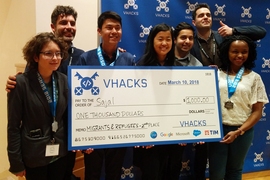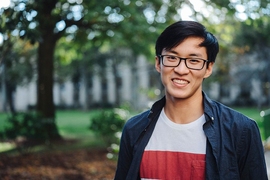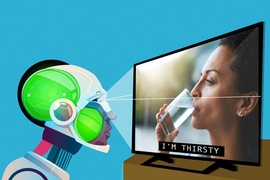To most of us, a 3-D-printed turtle just looks like a turtle; four legs, patterned skin, and a shell. But if you show it to a particular computer in a certain way, that object’s not a turtle — it’s a gun.
Objects or images that can fool artificial intelligence like this are called adversarial examples. Jessy Lin, a senior double-majoring in computer science and electrical engineering and in philosophy, believes that they’re a serious problem, with the potential to trip up AI systems involved in driverless cars, facial recognition, or other applications. She and several other MIT students have formed a research group called LabSix, which creates examples of these AI adversaries in real-world settings — such as the turtle identified as a rifle — to show that they are legitimate concerns.
Lin is also working on a project called Sajal, which is a system that could allow refugees to give their medical records to doctors via a QR code. This “mobile health passport” for refugees was born out of VHacks, a hackathon organized by the Vatican, where Lin worked with a team of people she’d met only a week before. The theme was to build something for social good — a guiding principle for Lin since her days as a hackathon-frequenting high school student.
“It’s kind of a value I’ve always had,” Lin says. “Trying to be thoughtful about, one, the impact that the technology that we put out into the world has, and, two, how to make the best use of our skills as computer scientists and engineers to do something good.”
Clearer thinking through philosophy
AI is one of Lin’s key interests in computer science, and she’s currently working in the Computational Cognitive Science group of Professor Josh Tenenbaum, which develops computational models of how humans and machines learn. The knowledge she’s gained through her other major, philosophy, relates more closely this work than it might seem, she says.
“There are a lot of ideas in [AI and language-learning] that tie into ideas from philosophy,” she says. “How the mind works, how we reason about things in the world, what concepts are. There are all these really interesting abstract ideas that I feel like … studying philosophy surprisingly has helped me think about better.”
Lin says she didn’t know a lot about philosophy coming into college. She liked the first class she took, during her first year, so she took another one, and another — before she knew it, she was hooked. It started out as a minor; this past spring, she declared it as a major.
“It helped me structure my thoughts about the world in general, and think more clearly about all kinds of things,” she says.
Through an interdisciplinary class on ethics and AI ethics, Lin realized the importance of incorporating perspectives from people who don’t work in computer science. Rather than writing those perspectives off, she wants to be someone inside the tech field who considers issues from a humanities perspective and listens to what people in other disciplines have to say.
Teaching computers to talk
Computers don’t learn languages the way that humans do — at least, not yet. Through her work in the Tenenbaum lab, Lin is trying to change that.
According to one hypothesis, when humans hear words, we figure out what they are by first saying them to ourselves in our heads. Some computer models aim to recreate this process, including recapitulating the individual sounds in a word. These “generative” models do capture some aspects of human language learning, but they have other drawbacks that make them impractical for use with real-world speech.
On the other hand, AI systems known as neural networks, which are trained on huge sets of data, have shown great success with speech recognition. Through several projects, Lin has been working on combining the strengths of both types of models, to better understand, for example, how children learn language even at a very young age.
Ultimately, Lin says, this line of research could contribute to the development of machines that can speak in a more flexible, human way.
Hackathons and other pastimes
Lin first discovered her passion for computer science at Great Neck North High School on Long Island, New York, where she loved staying up all night to create computer programs during hackathons. (More recently, Lin has played a key role in HackMIT, one of the Institute’s flagship hackathons. Among other activities, she helped organize the event from 2015 to 2017, and in 2016 was the director of corporate relations and sponsorship.) It was also during high school that she began to attend MIT Splash, a program hosted on campus offering a variety of classes for K-12 students.
“I was one of those people that always had this dream to come to MIT,” she says.
Lin says her parents and her two sisters have played a big role in supporting those dreams. However, her knack for artificial intelligence doesn’t seem to be genetic.
“My mom has her own business, and my dad is a lawyer, so … who knows where computer science came out of that?” she says, laughing.
In recent years, Lin has put her computer science skills to use in a variety of ways. While in high school, she interned at both New York University and Columbia University. During Independent Activities Period in 2018, she worked on security for Fidex, a friend’s cryptocurrency exchange startup. The following summer she interned at Google Research NYC on the natural language understanding team, where she worked on developing memory mechanisms that allow a machine to have a longer-term memory. For instance, a system would remember not only the last few phrases it read in a book, but a character from several chapters back. Lin now serves as a campus ambassador for Sequoia Capital, supporting entrepreneurship on campus.
She currently lives in East Campus, where she enjoys the “very vibrant dorm culture.” Students there organize building projects for each first-year orientation — when Lin arrived, they built a roller coaster. She’s helped with the building in the years since, including a geodesic dome that was taller than she is. Outside of class and building projects, she also enjoys photography.
Ultimately, Lin’s goal is to use her computer science skills to benefit the world. About her future after MIT, she says, “I think it could look something like trying to figure out how we can design AI that is increasingly intelligent but interacts with humans better.”










